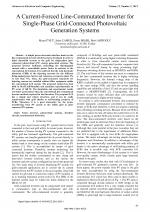| 2/2015 - 11 |
A Current-Forced Line-Commutated Inverter for Single-Phase Grid-Connected Photovoltaic Generation SystemsUNLU, M. |
| Extra paper information in |
| Click to see author's profile in |
| Download PDF |
Author keywords
inverter, photovoltaic systems, thyristor circuits, total harmonic distortion
References keywords
power(18), grid(13), connected(12), systems(10), line(6), inverter(6), commutated(6), single(5), photovoltaic(5), phase(5)
Blue keywords are present in both the references section and the paper title.
About this article
Date of Publication: 2015-05-31
Volume 15, Issue 2, Year 2015, On page(s): 85 - 92
ISSN: 1582-7445, e-ISSN: 1844-7600
Digital Object Identifier: 10.4316/AECE.2015.02011
Web of Science Accession Number: 000356808900011
SCOPUS ID: 84979846322
Abstract
A simple power electronic interface based on the line-commutated inverter (LCI) has been developed in order to inject sinusoidal current to the grid for single-phase grid-connected photovoltaic (PV) energy generation systems. The proposed inverter facilitates controlling the injecting/grid current with a controllable power factor in contrast to the conventional LCI system. It is achieved that the total harmonic distortion (THD) of the injecting currents for the different firing angles/power factors and reference currents is about 5% or less than 5%. Thus, the grid-connected standards for injecting current are satisfied without filter equipment unlike the conventional LCI system. The proposed system has been built in MATLAB/Simulink and examined experimentally on PV array of 160 W. The simulation and experimental results are better performance than the conventional line-commutated inverter methods reported in the literature. The proposed LCI has a simple and robust structure, and it can be easily synchronized with grid thanks to self-latching property of SCRs. Therefore, it is a good alternative for the power transferring from PV panels to the utility grid in grid-connected PV systems. |
| References | | | Cited By |
Web of Science® Times Cited: 4 [View]
View record in Web of Science® [View]
View Related Records® [View]
Updated 2 weeks, 6 days ago
SCOPUS® Times Cited: 6
View record in SCOPUS® [Free preview]
View citations in SCOPUS® [Free preview]
[1] Modeling and Control of Grid-Connected Photovoltaic Power Plant With Fault Ride-Through Capability, Al-Shetwi, Ali Q., Sujod, Muhamad Zahim, Journal of Solar Energy Engineering, ISSN 0199-6231, Issue 2, Volume 140, 2018.
Digital Object Identifier: 10.1115/1.4038591 [CrossRef]
[2] Parameter Improved Particle Swarm Optimization Based Direct-Current Vector Control Strategy for Solar PV System, NAMMALVAR, P., RAMKUMAR, S., Advances in Electrical and Computer Engineering, ISSN 1582-7445, Issue 1, Volume 18, 2018.
Digital Object Identifier: 10.4316/AECE.2018.01013 [CrossRef] [Full text]
[3] Solar PV Tied Electric Vehicle Charging System Using Bidirectional DC-DC Converter, Singh, Vikram, Kaur, Loveleen, Kumar, Jagdish, Singh, Amrita, 2022 Second International Conference on Power, Control and Computing Technologies (ICPC2T), ISBN 978-1-6654-5858-0, 2022.
Digital Object Identifier: 10.1109/ICPC2T53885.2022.9776973 [CrossRef]
Disclaimer: All information displayed above was retrieved by using remote connections to respective databases. For the best user experience, we update all data by using background processes, and use caches in order to reduce the load on the servers we retrieve the information from. As we have no control on the availability of the database servers and sometimes the Internet connectivity may be affected, we do not guarantee the information is correct or complete. For the most accurate data, please always consult the database sites directly. Some external links require authentication or an institutional subscription.
Web of Science® is a registered trademark of Clarivate Analytics, Scopus® is a registered trademark of Elsevier B.V., other product names, company names, brand names, trademarks and logos are the property of their respective owners.
Faculty of Electrical Engineering and Computer Science
Stefan cel Mare University of Suceava, Romania
All rights reserved: Advances in Electrical and Computer Engineering is a registered trademark of the Stefan cel Mare University of Suceava. No part of this publication may be reproduced, stored in a retrieval system, photocopied, recorded or archived, without the written permission from the Editor. When authors submit their papers for publication, they agree that the copyright for their article be transferred to the Faculty of Electrical Engineering and Computer Science, Stefan cel Mare University of Suceava, Romania, if and only if the articles are accepted for publication. The copyright covers the exclusive rights to reproduce and distribute the article, including reprints and translations.
Permission for other use: The copyright owner's consent does not extend to copying for general distribution, for promotion, for creating new works, or for resale. Specific written permission must be obtained from the Editor for such copying. Direct linking to files hosted on this website is strictly prohibited.
Disclaimer: Whilst every effort is made by the publishers and editorial board to see that no inaccurate or misleading data, opinions or statements appear in this journal, they wish to make it clear that all information and opinions formulated in the articles, as well as linguistic accuracy, are the sole responsibility of the author.



